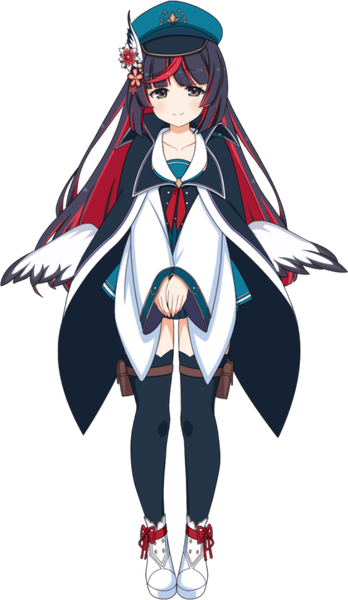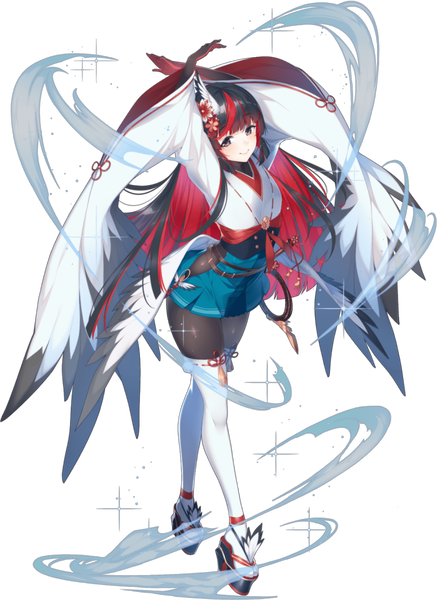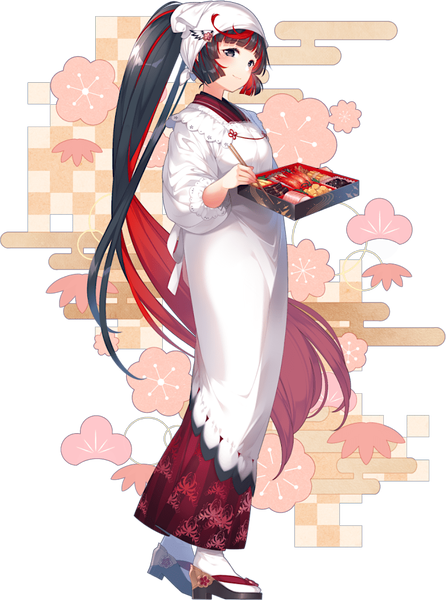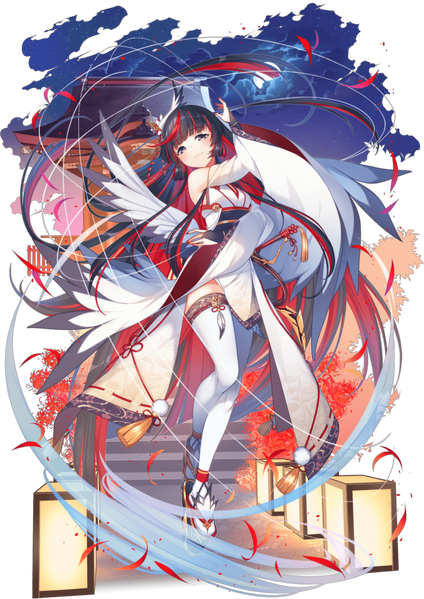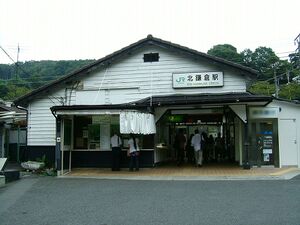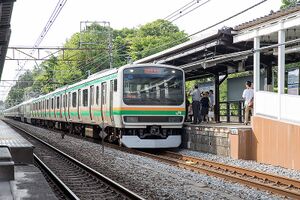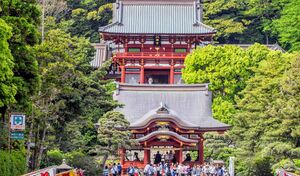Tsurugaoka
| Tsurugaoka | |||||
|---|---|---|---|---|---|
| Japanese Name | ツルガオカ | ||||
| Weapon | |||||
| Race | Beast | ||||
| Nationality | |||||
| Birthday | May 20 | ||||
| Constellation | Taurus | ||||
| Talents | Making fabrics from yarn spun with her own feathers | ||||
| Likes | Household chores, Antiquities, Ginkgo, Husbandry, Repayment of favors | ||||
| Dislikes | Ungrateful people, Revealing fashion, Modern entertainment | ||||
| Strengths | Good at general housework (especially weaving) | ||||
| Weaknesses | Ignorant of modern values and ethics | ||||
| Hobbies | Devoting herself to service her future husband | ||||
This is a matter of total silence under normal circumstances, but I will tell this to you, Teishu-sama. I am a member of the dark side of M. Nishiki, an assassination squadron known unofficially as the Yamiyo no Karasu. You can think of us as ninjas... or as they are called on the surface, or something else similar... We take on dirty work, which is more filthy and abhorred.
Layers
| Icon | Title | Release Date | Where to Obtain |
|---|---|---|---|
| [Crane's Return of a Favor] Tsurugaoka | 2022 May 31 | [Administrative Society Messiah] Pick Up Gacha, Premium Gacha | |
| [The Lone Crane Fluttering Silently] Tsurugaoka | 2022 April 22 | [Ice Flower Magic Teacher and the Lunatic Performer] Limited Gacha | |
| [Dearly Beloved] Tsurugaoka | 2024 January 12 | [The Uncaught Racoon in Jiulong Castle] Pick Up Gacha, Premium Gacha | |
| [Even a Chance Meeting is of Fate] Tsurugaoka | 2022 May 23 | [Subterranean Noble and the Dancing Crane Under the Moonlight] Limited Gacha |
Owned Skills
Trivia
- Tsurugaoka's birthday is the opening date of Kita-Kamakura Station in 1890. This station is the closest train station serving Tsurugaoka Hachimangū.
- Tsurugaoka's beast motif is the red-crowned crane, a large East Asian crane among the rarest cranes in the world. In some parts of its range, it is known as a symbol of luck, longevity, and fidelity.
- Tsurugaoka's hobbies and interests are themed after the story of Tsuru no Ongaeshi (鶴の恩返し, "Crane's Return of a Favor"), a story from Japanese folklore about a crane who returns a favor to a man. A variant of the story where a man marries the crane that returns the favor is known as Tsuru Nyōbō (鶴女房, "Crane Wife").
- Tsurugaoka's assassin background and her favourite food (ginkgo) is based on the legend of Minamoto no Sanetomo's assassination. Under heavy snow on the evening of February 13, 1219, Sanetomo was coming down from the Senior Shrine at Tsurugaoka Hachimangū after participating in a ceremony celebrating his nomination to Udaijin. His nephew, Kugyō, hid behind the ginkgo tree from beside the stone stairway of the shrine and assassinated him. For his act, he was himself beheaded a few hours later, thus bringing the Seiwa Genji line of the Minamoto clan and their rule in Kamakura to a sudden end. This very same ginkgo tree was toppled by strong winds in 2010.
- The building in the background of [Even a Chance Meeting is of Fate] is the Tsurugaoka Hachimangū, which is the basis of her name origin.
Counterpart
Kita-Kamakura Station (北鎌倉駅) is a railway station on the Yokosuka Line in Kamakura, Kanagawa, Japan, operated by East Japan Railway Company (JR East). Kita-Kamakura Station opened 20 May 1927 as a station on the Japanese Government Railways (JGR), the pre-war predecessor to the Japanese National Railways (JNR) to serve the Yokosuka Naval Arsenal and related Imperial Japanese Navy facilities at Yokosuka. It was initially a temporary stop, in operation from the months of May through October, but was upgraded to a full station on 1 October 1930, at which time the present station building was completed. The station came under the management of JR East upon the privatization of the Japanese National Railways (JNR) on 1 April 1987.
Kita-Kamakura Station has two opposed side platforms serving two tracks, which are connected by a level crossing at the Kamakura end of the platforms. The station building is located on the side of the up (Tokyo-bound) track at the end of the platform nearest to Kamakura. To reach the down platform, passengers must cross the tracks via a level-crossing.
On the side of the tracks leading away from Tokyo there is special exit which, like the Front Exit, is usable all day. It is mainly intended for disembarking, but passengers who already have a ticket from this station, or who are using a Suica or Suica-affiliated IC card can enter here. There is no automatic ticket gate, and only a very simple Suica touch point. There is one more special exit on the same side of the tracks, near the middle of the platform. It is only usable during the morning rush hour, Golden Week, and other times when the station is very crowded. During crowded weekend days and holidays there is a station attendant manning the ticket gate there, allowing payment in cash. A simple Suica touch point was installed in 2008.
The current station includes many stairs and the station is barrier-free in 2013. Elevators are installed where there are stairs, both platforms will have wheelchair ramps, extending the platforms by seven meters, the entire platforms will be covered by a roof, and a multi-purpose toilet will be installed. Wikipedia
Tsurugaoka Hachimangū (鶴岡八幡宮) is the most important Shinto shrine in the city of Kamakura, Kanagawa Prefecture, Japan. The shrine is a cultural center of the city of Kamakura and serves as the venue of many of its most important festivals with two museums. For most of its history, it served both as a Hachiman shrine, and in latter years a Tendai Buddhist temple typical of Japanese Buddhist architecture. The famed Buddhist priest Nichiren Daishonin once reputedly visited the shrine to reprimand the kami Hachiman just before his execution at Shichirigahama beach.
This shrine was originally built in 1063 as a branch of Iwashimizu Shrine in Zaimokuza where tiny Moto Hachiman now stands and dedicated to the Emperor Ōjin, (deified with the name Hachiman, tutelary kami of warriors), his mother Empress Jingu and his wife Hime-gami. Minamoto no Yoritomo, the founder of the Kamakura shogunate, moved it to its present location in 1191 and invited Hachiman to reside in the new location to protect his government. The shrine caught a major fire in 14 November 1280, where several artifacts were also stolen from the inner sanctum of the shrine.
The ginkgo tree that stood next to Tsurugaoka Hachimangū's stairway almost from its foundation and which appears in almost every old print of the shrine was completely uprooted and greatly damaged at 4:40 in the morning on March 10, 2010. According to an expert who analyzed the tree, the fall is likely due to rot. Both the tree's stump and a section of its trunk replanted nearby have produced leaves. The tree was nicknamed kakure-ichō (隠れ銀杏, hiding ginkgo) because according to an Edo period urban legend, a now-famous assassin hid behind it before striking his victim. For details, see the article Shinpen Kamakurashi. Wikipedia
Map
Gallery
- Pages using Tabber parser tag
- Pages using DynamicPageList3 parser tag
- Weapon Whip
- Beast
- Nishiki
- Taurus
- Element Blow
- Element Wind
- Element Fire
- Metro Train Knights
- Japan

